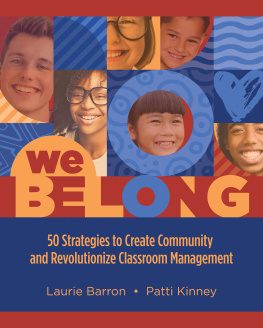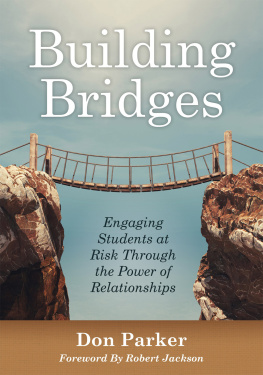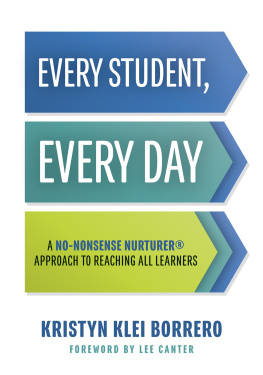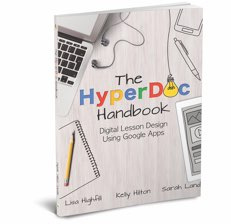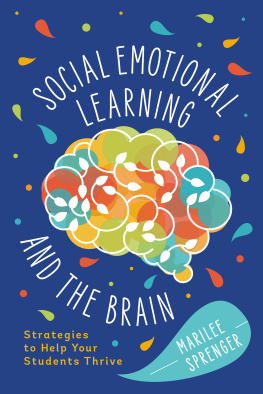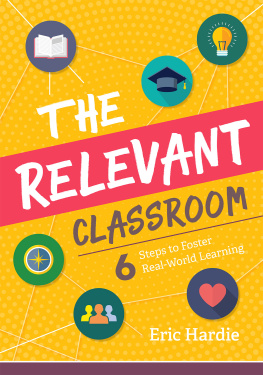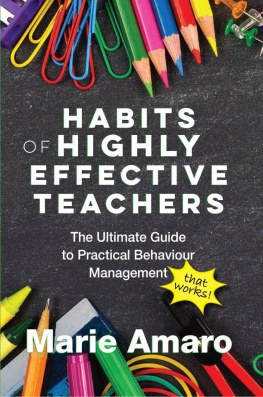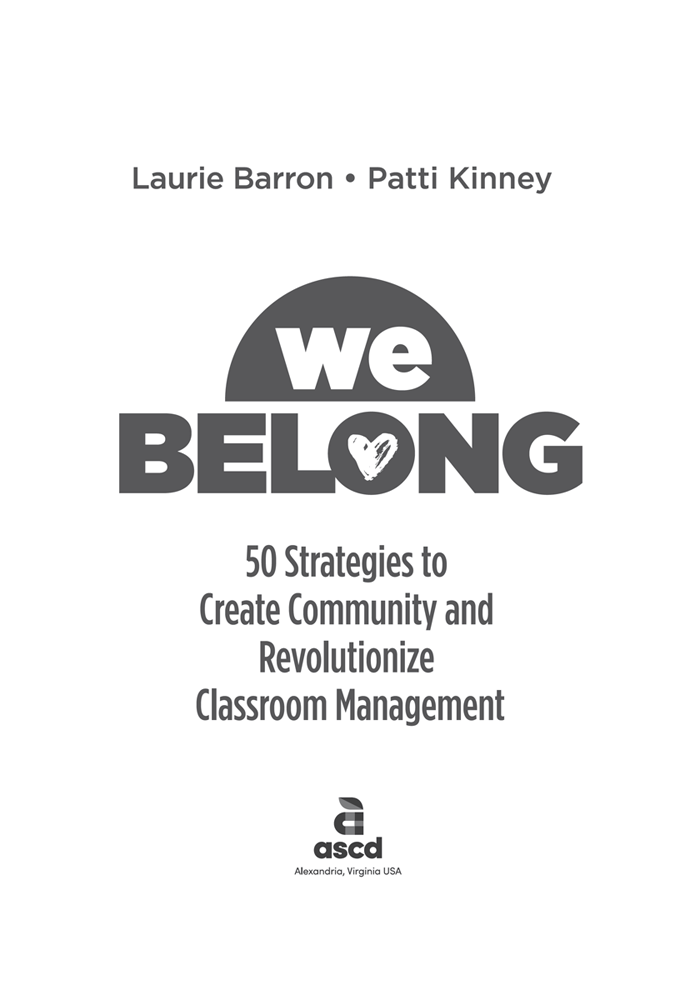Contents
Guide
Pages for We Belong
Acknowledgments
....................
We have leapt into another project togethera book on a topic for which we share a deep passion. How much more enjoyable it is to do this writing with support from others who are equally passionate about belonging!
"Thank you" and a simple acknowledgment does not seem quite enough for Marjorie Frank, our friend and colleague who has served as a highly talented consultant and editor on three separate projects now. Marj sees the big picture, understands the value that educators bring to their work each day, and shares her talents widely to continue to give back to the field.
We would like to offer a special thank-you to our educator colleagues and friends Erin Scholes and Carrie Wick, who helped review content and provided suggestions, thoughtful insights, and encouragement. And our deepest appreciation also goes to Cossondra Georgenot only for sharing valuable feedback on an earlier draft but also for writing a thoughtful foreword.
As teachers and administrators throughout our adult lives, our work with Talent Middle School in Oregon, Smokey Road Middle School in Georgia, and Evergreen School District in Montana has helped mold us into the educators we are. We are extremely grateful to the colleagues, students, parents, and community members who have worked alongside us; their influences on our growth, much of our work, and this book are immeasurable.
Finally, thank you to the friends and family who continue to support our desires to work hard and play hard. Laurie extends special thanks to her husband, Daniel, and daughter, Emma, for affirming her in following her passion and for reminding her to stay grounded. Patti thanks her husband, Dan, for supporting and encouraging her to continue doing the work she loves.
Foreword
....................
Throughout my many years as a middle-level teacher, I have come to understand that successful classroom management is rooted in building relationships with the students who walk through my door. Young adolescents are arguably the most difficult group of students to corral into some sort of organized chaos. For any teacher, fostering relationships and increasing belonging is critical but complex. What helps immensely when you're faced with a formidable student determined to challenge your authority? An arsenal of thoughtful and practical strategies.
Over the years, I've encountered my share of memorable students. I'm thinking of H. T., who proudly entered my classroom not only swearing, "I don't do math," but also bragging, "It won't matter anyway. I will be back in lockup soon." I'm also thinking of D. T., the 14-year-old 6th grader whose reputation with local law enforcement preceded him. And then there's B. G., who calls me every swear word (coupled with my name) that I've ever heard and even taught me a few new ones.
I would love to say these remarkable young people were unusual, but nothing with teaching is truly predictable or extraordinary. The middle and high school years are tumultuous for the easiest of pre-adolescents and adolescents, and they're downright torture for some of the rest. But with the right tools, a teacher can find ways to make headway with every student. All of my experience has taught me that helping students fit in and feel connected is the key to their success and the success of a classroom.
The key for H. T.? I let him sit in front of the room, next to me. He loved being "in charge," helping me, and having me nearby to help him. I discovered that he never ate lunch. So I kept cheese sticks, granola bars, and apple juice on hand for him to quietly grab when needed. This made a world of difference in his personality and behavior.
Reaching D. T. was harder, and I am sad to say that I never found the key to unlock his protective armor. How I wish that I'd had a resource like this book back then. I see in it a variety of new strategies I could have tried with him and many other students. Unfortunately, D. T. was unable to escape the school-to-prison pipeline, and 20 years later, I still feel responsible for not helping him find the sense of belonging that he neededand that might have changed the trajectory of his life.
B. G. and I still have our ups and downs, but the two of us have found ways to help her cope with her struggles to fit in. The key for her? A network of peers who model appropriate classroom behaviors. This helped B. G. feel that she belonged. It also helped her manage her behaviors, which let other students view her as a contributing member of our classroom.
The point of these vignettes is that each child is different. Every one of them walks through your classroom door with a unique set of insecurities and baggage and their own "combination lock." Deciphering that combination can be difficult. But if a teacher has a stock of strategies, the possibilities for unlocking good relationships and successful learning are endless. A book like We Belong can help you refine and organize practices you may have used in the past and teach you new strategies you can easily insert into any blank spots in tomorrow's plans.
When I first met Patti Kinney through the National Middle School Association, we were both part of a listserv (yes, that is how old-school people did things) called "MiddleTalk." Teachers posed questions about teaching adolescents and offered one another answers in long threads of discussion. Patti's voice was one I followed and respected. Over the years, we have bumped into each other in many virtual settings, and I have been a fan of her writings and thoughts. Her book Voices of Experience: Perspectives from Successful Middle Level Leaders touched me with its honesty and insights into middle-level education. Patti introduced me to Laurie Barron, whose wisdom I have come to value. Her expertise informs the professional development opportunities she provides to teachers and school leaders everywhere. These two outstanding educators collaborated on Middle School: A Place to Belong and Become, a book that has been the trusted guide for my classroom structure since it was published in 2018. The weaving of their individual experiences creates a readable, usable text. I've reached for it so often that the pages are already dog-eared and filled with notes.
I've repeatedly referred to middle school students because they have been the focus of my professional life. However, I've always felt that, if a strategy can work with this age group, it can work with any students! This book does a fantastic job of embracing a wide span of teachers and learners, offering ways to apply the suggested strategies to different grade levels and subject areas. For example, the section on Daily Agendas demonstrates three different ways to adapt the strategy. Any teacher would be able to use the examples in his or her own classroom with ease.
One of my favorite gems mined from this book is Strategy 42: "Help students make friends with failure." Many of a teacher's biggest behavior challenges are from students who feel "dumb"; because they believe that they are not ever going to be academically successful, they choose to act out instead of continuing to try. Strategy 42 outlines ways to find an inroad with those students, by getting them to understand that failure is a part of all of us and that it is a natural part of success and learning. I love the suggestions offered here to help students overcome their fears. Another favorite is Strategy 8: "Build belonging with relationship promises." I love the list of promises and the suggestion to review it and repeat the promises to yourself monthly over the school year. I know that I need an occasional pick-me-up boost to remind myself of the importance of all those small things that help build and maintain good teacherstudent relationships.

